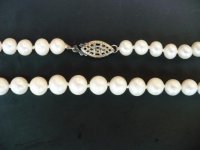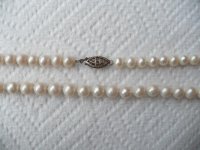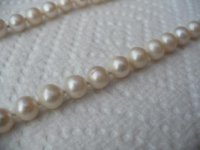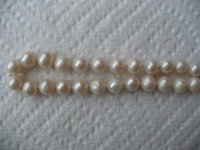hello. i come to you all for assistance and opinions on a strand as most of my pearl research has lead me back to this forum in one sort or another. this site is a great wealth of information and here is a thanks upfront. so while i am fairly decent in identifying unmarked precious metals and gems, pearls are not yet on my list. it doesnt help that i am colorblind, but that also forces me to use many other empirical methods. but maybe you take one look at the strand and can nail it down on color alone. i could not.
as for provenance, i would prefer to withhold it. i do not want to sway opinions by means of stories which can be false to start with even if dearly held to be true. so i will begin with basic observations and move on to thoughts and questions (in bullet form).
- passes tooth test and gently rubbing pearls together. yes they have the proper grittiness.
- there are no chips of nacre revealing a bead nucleus as i have seen on some strands before.
- to me color seems very well matched but not perfect by any means, but again, i am colorblind. i can however tell that there are certainly differences in brightness and the amount of light or clarity of light that is reflected. sorry for not remembering the proper terms here. as for overtones as i have read about, i cannot say i completely understand this to give my interpretation. plainly, some pearls are very brilliant in shine, some rather dull, some slightly lighter others slightly darker.
- i would say they are heavy for their size and are definitely cold to a touch on the cheek.
- the clasp is not all that fancy and is marked on one side "14k 102 Z" this is not marked on the boomerang part, but on a side piece of the larger housing.
- the length is 16". i dont know whether to include the clasp or not, but either way, lets call it 16".
- there are 63 pearls
- i carefully measured the pearls with a micrometer and they measured from about 4.5mm to 7.8mm.
- they seem to be all rather round but definitely not completely the same. and i would not say that they do not look potato shaped. from a foot or so an observant eye could tell that they are not all the same in shape
- i weighed the strand with the clasp hanging off the scale and it was 21.2 grams which converts to 106 carats. if the string were to weigh .8 grams, which seems feasible, that would leave the pearls at 102 carats. could that be what the marking on the clasp is referring to? the weight of the pearls in carats? or maybe it is just a model number for the clasp? i dont know.
- i have inspected the pearls on a box with a small hole cut in it to set a pearl in and with a bright light behind it. i did not see any horizontal or striped bands running through them. some had a darker nucleus which would be small, but i would say that no two were the same. i can provide images of this. i got this idea from somebody on this forum.
- one characteristic of about 3 or 4 of the pearls that i would like to point out is that towards the outer layers in the nacre there seems to be a small pitted hole with a tail that follows behind it. as if something was lodged into the nacre and grew along with it causing a striped scar. you can see this in one or two of the images.
- i have peered into the pearls with a loupe as much as i could with them on the string and so far, no signs of a separation or line of change. it all seems one consistency.
- some pearls have a scaling effect on them. to me its like looking at the moon. but this is on very close inspection under a loupe. i can provide images under the loupe.
- i have viewed them under a blacklight, but it didnt help me much because that test seems to be about how the pearls react to color. images can be provided.
- the images that are provided here were taken outside on a cloudy day on paper towel and a black paper.
sorry for all that. ill cut it there but it could be much longer. thats what happens when you dont have anybody else around who wants to hear about your pearl observations. so here i leave it for your thoughts. as i really do not think these pearls have a bead nucleus, my main question is could these be freshwater pearls? just for sheer probability i will have to doubt natural saltwater. i am not opposed to breaking the string to look inside of the drill holes, but ill wait for you all to tell me if i should or not. i am very surprised i have resisted to cut the rope for this many years.
thank you in advance for all opinions. and again, thank you all for feeding yet another passion that will always remain.
best of it.
edit: upon reviewing this posting, i noticed that the images are shrunk down very much to the point where you cannot see detail. if there is a way to upload hi res images in a post, let me know and i will do so or i can email images as well. thank you.
as for provenance, i would prefer to withhold it. i do not want to sway opinions by means of stories which can be false to start with even if dearly held to be true. so i will begin with basic observations and move on to thoughts and questions (in bullet form).
- passes tooth test and gently rubbing pearls together. yes they have the proper grittiness.
- there are no chips of nacre revealing a bead nucleus as i have seen on some strands before.
- to me color seems very well matched but not perfect by any means, but again, i am colorblind. i can however tell that there are certainly differences in brightness and the amount of light or clarity of light that is reflected. sorry for not remembering the proper terms here. as for overtones as i have read about, i cannot say i completely understand this to give my interpretation. plainly, some pearls are very brilliant in shine, some rather dull, some slightly lighter others slightly darker.
- i would say they are heavy for their size and are definitely cold to a touch on the cheek.
- the clasp is not all that fancy and is marked on one side "14k 102 Z" this is not marked on the boomerang part, but on a side piece of the larger housing.
- the length is 16". i dont know whether to include the clasp or not, but either way, lets call it 16".
- there are 63 pearls
- i carefully measured the pearls with a micrometer and they measured from about 4.5mm to 7.8mm.
- they seem to be all rather round but definitely not completely the same. and i would not say that they do not look potato shaped. from a foot or so an observant eye could tell that they are not all the same in shape
- i weighed the strand with the clasp hanging off the scale and it was 21.2 grams which converts to 106 carats. if the string were to weigh .8 grams, which seems feasible, that would leave the pearls at 102 carats. could that be what the marking on the clasp is referring to? the weight of the pearls in carats? or maybe it is just a model number for the clasp? i dont know.
- i have inspected the pearls on a box with a small hole cut in it to set a pearl in and with a bright light behind it. i did not see any horizontal or striped bands running through them. some had a darker nucleus which would be small, but i would say that no two were the same. i can provide images of this. i got this idea from somebody on this forum.
- one characteristic of about 3 or 4 of the pearls that i would like to point out is that towards the outer layers in the nacre there seems to be a small pitted hole with a tail that follows behind it. as if something was lodged into the nacre and grew along with it causing a striped scar. you can see this in one or two of the images.
- i have peered into the pearls with a loupe as much as i could with them on the string and so far, no signs of a separation or line of change. it all seems one consistency.
- some pearls have a scaling effect on them. to me its like looking at the moon. but this is on very close inspection under a loupe. i can provide images under the loupe.
- i have viewed them under a blacklight, but it didnt help me much because that test seems to be about how the pearls react to color. images can be provided.
- the images that are provided here were taken outside on a cloudy day on paper towel and a black paper.
sorry for all that. ill cut it there but it could be much longer. thats what happens when you dont have anybody else around who wants to hear about your pearl observations. so here i leave it for your thoughts. as i really do not think these pearls have a bead nucleus, my main question is could these be freshwater pearls? just for sheer probability i will have to doubt natural saltwater. i am not opposed to breaking the string to look inside of the drill holes, but ill wait for you all to tell me if i should or not. i am very surprised i have resisted to cut the rope for this many years.
thank you in advance for all opinions. and again, thank you all for feeding yet another passion that will always remain.
best of it.
edit: upon reviewing this posting, i noticed that the images are shrunk down very much to the point where you cannot see detail. if there is a way to upload hi res images in a post, let me know and i will do so or i can email images as well. thank you.








